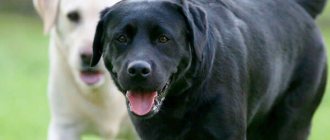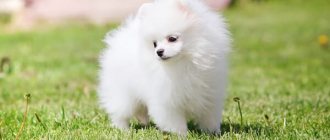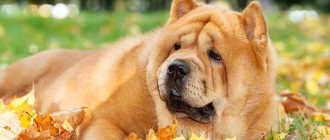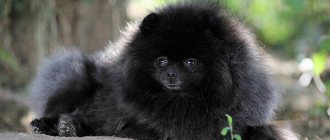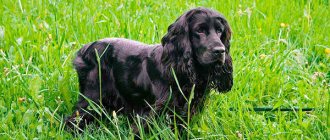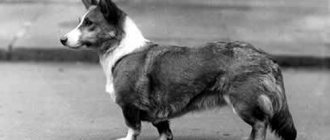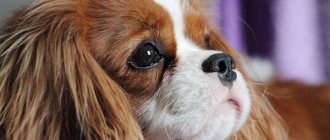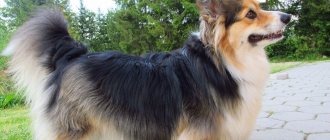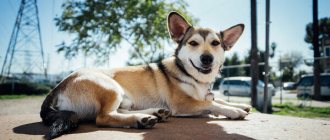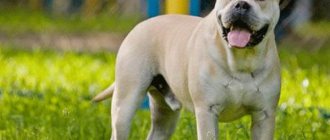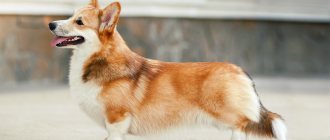Small representatives of Welsh Corgi dogs were brought by the Celts in the 10th century to Wales, which is still considered the birthplace of the breed.
They were originally used as herding dogs.
The official date of appearance (or, rather, registration) of this breed is 1892.
Since then, corgis have been actively gaining popularity all over the world. This is facilitated by the cute appearance of the teddy bear and cheerful, kind disposition.
Fluffy - defect or breed?
It so happens that the Fluffy Welsh Corgi is considered a breeding match. This is justified by the fact that in the genetic chain of such dogs there is a “fluffy” gene, which greatly changes the structure of the coat.
NOTE!
The road to exhibitions and competitions is closed for these kids; such dogs are not allowed to be bred, they are culled from the litter.
Caring for Corgi Fluffy
The only significant difference between the classic Welsh Corgi and Fluffy is that long hair makes caring for the dog much more difficult. And owners planning to get just such a non-standard puppy should be prepared for this.
Long hair: advantage or disadvantage?
Firstly, it is beautiful - the long fur is soft and silky, it is very pleasant to stroke it. However, there will be no “secondly” - this is where all the advantages of the fluffy fur coat end and the disadvantages begin:
- wool behaves like cotton wool - it gets tangled from rain, snow and simply from who knows what;
- combing should become a daily procedure;
- Long-haired corgis need to be bathed more often than standard ones;
- Fluffy's shedding is very pronounced, and there is also a specific shepherd's odor;
- It is not advisable for allergy sufferers to have such a dog.
Fluffy is not averse to a swim in the river, but after that the wool will take a long time to get in order
But all these minor inconveniences can be easily overcome if you want your beloved dog to be beautiful and feel comfortable.
Photo gallery: daily care for Corgi Fluffy
When caring for fur, you need various brushes and combs, and a furminator is a must.
Regularly examine your dog’s teeth so as not to miss the appearance of plaque - in the initial stage it is easy to get rid of
You don't have to go to the vet to clean your eyes and ears once a week.
Nails need to be trimmed as they grow.
In wet weather, walk your dog in overalls
Does the gene affect a dog's health?
The presence or absence of the hidden fluffy gene does not in any way affect the health of your pet. This is not a disease, and the life expectancy of long-haired fluffies does not differ from how long all representatives of the breed delight their owners - on average it is 10–12 years.
Fluffy is as cheerful and playful as short-haired corgis
How do they appear?
"Fluffy" is a "coat gene" that makes dramatic changes to a dog's coat.
The first signs of “increased shaggyness” in a corgi appear by the age of one month - a little more puppy fluff appears on the puppy’s paws than the rest.
It is almost impossible to recognize fluffy at earlier stages of life. However, it is possible to predict the appearance of such corgis - it is enough to know that both the mother and father of the puppies are carriers of this hidden gene.
Features of junior molt
The junior moulting period begins at approximately one year of age (at 10-15 months of age). In a one-year-old dog, literally kilograms of fluff are combed out; guard hairs come out especially strongly on the sides and collar. At this time, it is advisable to visit a groomer, wash the animal, and “blow out” excess hair.
Junior molt is the most abundant, but it occurs in different ways. Some corgis become “bald” for several months - you can’t look at them without tears; in others, the hair simply comes out in clumps, but quickly grows back. Some owners get scared and start giving the dog all kinds of vitamins and dietary supplements, but veterinarians think that this is unnecessary. After a complete change of the “baby” fur, a new one grows - long, thick.
How to avoid appearance?
Typically, breeders carefully track the pedigree of potential litter parents. It is important to pay attention to the presence of at least one, even a distant relative, in whom this gene manifested itself. Such dogs are no longer allowed for breeding.
However, no breeder is immune from this “wool surprise”.
How to treat fluffy
As stated earlier, neither the Pembroke Fluffy corgi nor the Cardigan Fluffy are allowed to show. Some well-known breeders, giving the dog to other owners, enter into an agreement with them, which stipulates the condition - to castrate or sterilize the dog at a certain age. Some kennel owners carefully select their dogs to avoid Fluffy Corgis.
Bitches are sometimes allowed for breeding in countries where the population of this breed is very small. This applies especially to cardigans, since their gene pool is several times smaller.
Breeders claim that fluffies take the best from their parents' exterior and have an amazing character. It has been scientifically proven that the hair gene is inextricably linked with the genes responsible for character. The result of this combination is a long-haired Corgi with a wonderful character.
According to another version, a single dog gene produces a protein that breaks down into parts, affecting behavior in one part and coat structure in another.
Description of the variety
In fact, fluffies do not reveal their interesting variety . They, like other corgis, have large erect ears, a long muzzle, and short but strong paws. The body is elongated and strong. Charming dark eyes set far apart.
It takes on the color from its parents. Most often these are classic “Corgivian” colors.
Fluffiches have long fur, so they need to be combed very often, their bellies washed after each walk, and their “fur coat” cleaned of leaves/sticks/snow.
Appearance
The Fluffy Corgi has a very soft and fine coat. There are fringes behind the ears, and a dewlap on the tail (if it is not docked). The fur on the belly and inner thighs is especially long.
Otherwise, the Cardigan and Pembroke Fluffy are no different from classic dogs. They have the same build, cute face, identical color. However, due to their fluffiness, they look somewhat larger and more voluminous than their relatives, although they have the same height and weight.
For your information. Some long-haired dogs have soft ear cartilage, causing the tips of their ears to droop slightly.
Character traits
Despite the “cuteness” that corgis radiate, we must not forget that this breed is a distant relative of shepherd dogs . They can show good protective qualities or try to protect their owner even in those moments when this is not required.
Otherwise, representatives of this breed are kind-hearted creatures who adore children. All breeders unanimously say that corgis make excellent contact with children.
The breed is characterized by cheerfulness and energy, and in contrast, they always follow the owner’s commands.
Education and training
Training a Cardigan Welsh Corgi
In training, Cardigan Welsh Corgis show themselves on the most positive side. The main thing is not to overdo it with seriousness and monotony. Due to their moderately lively temperament, cardies are happy to learn what is presented to them in a relaxed, entertaining form and quickly lose interest in commands and actions that imply stupid execution of the master's demands. Do not forget that the Cardigan Welsh Corgi is a highly specialized herding shepherd dog, which is not at all intended for service and security activities.
Start raising and socializing your puppy from the first minutes of his appearance in your home, and not at 6 months of age, as would-be experts on Internet forums advise you to do. The training of a 2-month-old baby is built approximately in the following sequence:
- familiarization with the home toilet (tray, diaper) and the ability to use it;
- leash and collar training;
- instilling obedience and setting boundaries of what is permitted.
At 3 months, a puppy can and should begin to be introduced to the outside world so that he does not get the impression that he is the only four-legged creature on the planet. To do this, walk more often in places where other animals (cats, dogs) run, and also arrange for your pet to meet people. At the same time, clearly explain to your baby that now the toilet for him is not only a tray and a diaper, but also the nearest bushes.
At 4-5 months, the Cardigan Welsh Corgi is smart enough to learn a minimum set of commands: “Near!”, “Sit!”, “Lie down!”. In addition, a 4-month-old puppy must understand that barking without a reason is the height of bad manners, and picking up foreign objects from the ground, even if they smell temptingly, is an activity unworthy of a real Welsh Shepherd.
Cardigan Welsh Corgi training
Important: teaching a Cardigan circus and acrobatic acts is not prohibited, unless it is jumping. Climbing onto horizontal surfaces and diving down from them is strictly contraindicated for representatives of this breed (they have paws, if you remember)
In the process of training six-month-old individuals, take into account the characteristics of adolescence. During this period, the Cardigan Welsh Corgi may deliberately disobey you and pretend to be incomprehensible. This breed is not prone to dominance, but the 6-month-old puppy will definitely try to bargain for some concessions. In addition, he may begin to spoil his shoes again, although three months ago he demonstrated complete indifference to such things.
Advantages and disadvantages
The advantage of the breed is its very powerful skeleton. Due to their small stature and strong muscles, the dogs are very hardy and strong.
They are easy to train. They obey their owner unquestioningly and master commands on the fly.
This breed is perfect for living in an apartment due to its size, which can also be considered a positive thing.
IMPORTANT!
The downside of fluffy is the complete absence of undercoat.
“Classic” corgis have a rather dense undercoat. Fluffies' fur gets wet very quickly in any rain; in winter, lumps of snow stick to the dog, and in summer, twigs and leaves get tangled in it.
Also, a dog’s hyper-attachment can also be a big inconvenience for the breeder. She falls in love with her owner and experiences great stress during any, even short, separation.
Dog nicknames: names for Welsh Corgis
Names for boys Welsh Corgi
- HAGGEI (from other Hebrew “festive”, “merry”). By nature, the dog should be kind, fast, and personable.
- AMETHYST. The nickname is given in honor of a beautiful gemstone. The dog has a proud character and is very attached to its owner. Change of owner is difficult to bear.
- BARSIK. This is a small domestic dog. They have a kind, calm disposition and love children very much.
- BIM. The nickname is borrowed from the film by G. Troepolsky “White Bim Black Ear.” The dog's name itself is kind. Dogs are highly trainable; They love children, are not malicious, they love their owners very much, they are devoted to them. Very smart. They don't leave their home.
- HAROLD (from other Germanic “army” and “to command”). The dog has a complex character. She is stubborn, proud, courageous, self-confident, and efficient.
- GASTON (from other Germanic “guest”, “foreigner”). The man's name became the dog's name. This nickname is given to large and small purebred dogs of noble origin.
- GIDEON (from other Hebrew “slasher”, “to chop”). This nickname is given to a brave, strong dog.
- GORDON (from a Scottish surname). The nickname is not new, but it is rare. These are strong dogs with an excellent sense of smell and are easy to train. This nickname can only be given to purebred dogs.
- JARED, JARED (from Latin, Greek, other Hebrew “descended”). This is a calm dog.
- JASON (from other Greek “healer”). Dogs with this nickname are completely gentle, the kindest domestic creatures.
- JOHN (from other Hebrew “John”, “god bestowed”, “given by God”). In the Bible the name of the baptist and apostle. This nickname can only be given to purebred medium-sized dogs. They have a good disposition. Winter ones are stronger than summer ones. Dogs are touchy, so it’s best not to let them off the leash. These dogs love their mistress more than their owner.
- JULBARS. This is a strong, brave, angry dog that obeys only its owner. Patient with pain. Kind to those who care for her.
- DOMINIK, DOMENIK (from Latin “dominant”). This beautiful nickname is for medium-sized dogs, exclusively purebred.
- BUG, BUG. A small, fluffy, capable dog. Strong and brave. He is easy to train and can work as a circus performer.
- ICARUS (from Latin, Greek, “dedicated to the Moon”). In Greek mythology, Icarus, the son of Daedalus, escaped from captivity on the island of Crete, flying away on wings made from feathers and wax by his father. This is a beautiful name for a dog. This is a kind dog, easy to train, recognizes only its owner, is very efficient, and a good watchman.
- CALVIN. Puppies are often given this nickname for their beauty. Nickname for purebred medium-sized dogs.
- QUINT (from Latin “fifth”). This nickname is given to purebred dogs with a calm disposition. You need to be strict when dealing with them. These are kind, efficient dogs that are easy to train, but do not like cruel treatment.
- KARL (from other Germanic “courageous”, “man” and “man”). These are usually small dogs that can be trained.
- CLARK. The nickname comes from the surname. This is a small domestic dog, strict, when meeting loved ones, it always barks when greeting the owner, as if saying hello!
- CLAUDE (French version of the name Claudius from the Latin “lame”). This is a nickname for dogs that are small, kind, loving children, and well trained.
- KIN. Translated from the language of the inhabitants of the Isle of Man (in the Irish Sea) it literally means “warrior”. The dog is kind and affectionate in nature; good athlete.
- MILAN (city in Italy). These are large, kind domestic dogs, loving children, warm-hearted and calm.
- MICAH (an abbreviation of the other Hebrew name “like the god Yahweh”). The nickname is given to a gentle, affectionate creature, devoted to its owner.
- MORGAN (“great”, “light”, “bright”). This nickname should be given to a calm dog who loves people.
- NOUA (“peace”, “calm”). This nickname should be given to phlegmatic dogs, small ones and only domestic ones. These dogs have a calming effect on humans.
- ORESTES (from Greek, “mountain”). This is a large, calm dog, very attached to its owner, although it does not tolerate changes in ownership too painfully.
- OSCAR (from other herm, “god” and “spear”). The character of such dogs is complex. These are smart, proud dogs who love children and do not offend anyone.
- FLUFF. A small fluffy dog that is easy to train. These kind dogs warmly welcome members of the owner's family. They love to play with children.
- GLAD. The nickname comes from the word “rejoice.” It can be given to any dog. These strong, hardy dogs are kind, but they love to scare people with their roars. Nickname for purebred dogs.
- TEMOTHY, TIMOTHY (from the Greek “honoring”). These are dogs with an impulsive temperament, hardy, hardworking, but not leaders.
- TIFFANY (derivative of another Greek “god shows”, Russian Feofan). A dog with a calm, kind disposition. Somewhat phlegmatic. Loves children.
Best articles: Shikoku is a rare dog breed bred in Japan
Photos of colors
The color of dogs is varied. It can be a solid color (any color) with white spots. Can be black, sandy, red (red), black and tan.
The classic “tricolor” is also often found - light red, black and white.
Often the Corgi's legs and chest are white.
Maintenance and care
The first thing to remember when buying a Corgi (it doesn’t matter: Pembroke, Cardigan or Fluffy) is that dogs are extremely active . Clumsy at first glance, they display agility by jumping and running while walking. Therefore, you will have to walk a lot. You can't get away with a half-hour evening promenade here.
Teeth brushing and nail trimming are just as important for babies as they are for other dogs. These procedures should not be neglected.
NOTE!
You will have to tinker with the wool. Taking into account its fluffiness and length, your pet will have to be combed often. After each walk, you need to pull out branches and leaves, and in winter, clean out the snow.
As mentioned above, fluffies have no undercoat. Even if there is light drizzle and wind outside, the walk will have to be limited in time, because... the animal will get wet and freeze very quickly, even if it moves constantly.
Nurseries
It is not recommended to buy a puppy secondhand or through advertisements from people with an unverified reputation. To purchase a puppy, it is better to contact professional nurseries. A decent breeder will tell you straight out that Fluffy is not a dog for exhibition, but a pet for the soul. If the seller starts talking about how the long-haired corgi is the newest type of breed, it is better to run away from there as quickly as possible. Most likely, the owner of the puppies is trying to mislead potential buyers.
In any Welsh Corgi nursery you can find fluffy puppies, since the risk of such non-standard babies is always high.
Breed:
- Nursery “Talisman Vasilisa”, Rostov region, Taganrog, www.lisatalisman.com
- Nursery “Zelveger” St. Petersburg, zelveger.ucoz.ru
How to walk correctly?
With such an active dog, any walk should be accompanied by games of ball, tag, “flying saucers” and other activities. Evening walks should be especially full of movement so that the little dog’s energy is depleted and he sleeps peacefully at night.
Of course, it is necessary to ensure that flaffies do not take anything from the ground. You should not let them rummage through heaps of autumn leaves, because, in addition to the health hazard, this will cause inconvenience to the owner, because all this foliage, along with the dog’s fur, will come into the house.
What is the fluffy gene
Fluffy is the conventional name for the gene for long hair in dogs; it is present in many breeds, but only in the Welsh Corgi its name was assigned to a special breed variety. Long-haired puppies can be born from quite standard parents with short hair, if both of them are carriers of the “cunning” gene.
These two littermates differ solely in the length of their coat: the left one is a fluffy, and the right one is a standard Welsh Corgi.
Being in a recessive state, the fluffy gene does not in any way affect the appearance of the dog, but individuals with a dominant fluffy will definitely have long and very soft hair, practically devoid of guard hair. Such fluffies do not meet corgi standards and are therefore considered a defect in the breed, although they look very cute.
What do fluffy corgis look like?
Fluffy is the same corgi, only very woolly. Due to this, they may appear larger than their “correct” counterparts, although they do not differ at all in height and weight. Puppies look especially funny - fluffy balls on short legs.
Corgi puppy looks like a fluffy hedgehog
Growing up, these special children turn into beautiful long-haired dogs, in which all the signs of a corgi are clearly visible. Fluffies are equally common in both corgi breeds: both Pembrokes and Cardigans - they comply with their breed standards, including the list of desirable colors.
Fluffy has soft not only fur, but also cartilage in his ears
The ears are another distinctive feature of fluffies - the cartilage in them is quite soft, so the ears may not turn out erect, like those of ordinary corgis, but slightly drooping at the ends.
Does the gene affect the breed level?
The quality requirements for Welsh Corgi wool are high, and any fluffy will be immediately disqualified by experts. Cute shaggy dogs cannot participate in breeding, but given the prestige and high cost of the breed, such individuals are bred more often than one might imagine.
Fluffy is persona non grata at exhibitions
It’s also good if a guaranteed partner, pure in genes, is selected as a mate - then fluffy carriers endowed with a standard appearance will be born in the litter.
At what age can fluffy be considered?
All corgi puppies are born with seemingly the same fur - it is shiny, short and tightly fits the body of these “hamsters”. Only a very experienced breeder’s eye is able to discern the fluffy signs that are still hidden from everyone in newborn babies.
Newborn corgi puppies do not show the presence of the fluffy gene
But by about a month of age, the first obvious signs appear: on the paws and behind the ears, the hair begins to grow faster, becoming longer than the main coat.
You can notice signs of long hair in a one-month-old Fluffy puppy.
Further changes occur rapidly - the one and a half month old Fluffy puppy cannot be confused with his brothers who do not have the “wool gene”. So at the time of the litter activation, everything secret will definitely become clear, and an offensive o will appear in the metric of special babies - this stigma will affect their entire future life.
By one and a half to two months, fluffy puppies are already noticeably different from their littermates.
Is it possible to avoid this anomaly?
Breeders engaged in breeding work and setting the improvement of the breed as their main goal, be sure to test producers for the presence of the fluffy gene - this makes it possible to fairly accurately predict the appearance of the expected offspring. Simple tracking of a dog's pedigree lines cannot provide any guarantee of the absence of fluffy.
The test for long hair is done in domestic laboratories within ten days; it is completely simple and not dangerous for the dog. The cost of testing one individual does not exceed two thousand rubles.
Having reliable data about the genetics of a breeding couple, you can easily calculate the prospects of its offspring - this is very interesting:
Life expectancy and health
Corgis live quite a long time. On average, life expectancy is about 10 years.
Despite their endurance, these dogs are prone to colds (due to the fact that fluffy has no undercoat). Therefore, it is very easy to get pneumonia or other diseases based on a cold.
In addition to colds, the Corgi breed itself is often carriers of chronic diseases, such as:
- Cataract . An eye disease when bright light blinds the pet and prevents it from seeing normally. This happens due to clouding of the main part of the eye - the “lens”.
- Epilepsy . Yes, some babies suffer from this terrible disease. Manifests itself in the form of seizures.
- Hip dysplasia Closer to old age, this becomes especially noticeable, because... The dog begins to limp constantly. The owner needs to closely monitor his dog with this disease, because... A dog can sprain its paw at any time.
- Behavioral disorders . Sometimes it happens that the dog begins to aggressively attack the owner and family members. Or, on the contrary, he begins to be afraid of everyone and hides.
- Narcolepsy . The dog just suddenly falls asleep. Walked and fell asleep. I ate and fell asleep. An extremely dangerous disease, if you imagine how it can turn out.
- Bleeding disorders are common in Corgis.
- Thyroid problems.
History of the origin of the breed
The very name of the Welsh Corgi breed reveals its place of origin – Wales.
There are two subspecies of the Welsh Corgi: the Cardigan Welsh Corgi and the Pembroke Welsh Corgi. The first appeared in an isolated area of Cardiganshire, Wales. One theory is that the Cardigans' ancestors were brought to the British Isles by the Celts at the end of the Bronze Age.
As for the Pembroke Welsh Corgi, this breed is native to Pembrokeshire, Wales, and has its origins in the 13th century, presumably from dogs of Flemish origin. According to one version, King Henry of England had a hand in the appearance of corgis in the British Isles. In 1107, he invited Flemish weavers, who, in turn, brought with them small Spitz-like dogs.
photo: malteze.net
The first written mention of the corgi breed appeared in the code of laws of King Hywel the Good, who ruled Wales in the 10th century. One of the laws stated that for the murder of a corgi herding cattle, its owner could demand compensation from the culprit in the form of a whole ox.
The main function of Welsh Corgi dogs in those days was herding. This breed of dog was held in high esteem, as they could herd herds of sheep, herds of ponies, and even poultry (geese and ducks) without human intervention. Corgis also guarded farmland and the houses of their owners. Corgis could independently watch over the herd all day, protecting it from wolves and robbers. Therefore, it is understandable that the death of a shepherd dog was a tangible loss for the owner.
For their miniature size, corgis received the nickname “Welsh yard” - from the tip of the nose to the base of the tail, their body length does not reach even a meter. Corgis were also called “nipper dogs” because of their specific manner of biting cattle grazing on the pasture on the hind legs. The short limbs of dogs make them more maneuverable and protect them from injury, blows from animal hooves and horns.
photo: simple-fauna.ru
There is also a version that the Corgi breed originated from the Schipperke, Samoyed, Keeshond and Norwegian Spitz. But the main ancestors, most likely, were the Icelandic dog and the West Goth Spitz (also known as the Swedish Vallhund). Today, both breeds are extremely rare.
photo: petstime.ru
There is also controversy about the origin of the very name of the breed “Corgi”. Some researchers are sure that it came from the Welsh “cor” (dwarf) and “ci” (dog). Others insist that the name is based on the words “cur” (to watch, guard) and “ci” (dog), so the name of the breed is translated as “guard dog”.
Despite all its merits, the Corgi breed was not widespread until 1892
Corgi dogs managed to attract attention after they took part in an exhibition show in 1892, where breed standards were determined and its best representatives were identified. After this, the popularity of the breed began to grow quite quickly in many countries of the world, including Russia.
So, in 1933, the Duke of York gave his daughters Elizabeth and Margaret a puppy each. It is known that corgis captivated the heart of little Elizabeth so much that even after becoming Queen Elizabeth II, she kept this particular breed of dog at court all her life.
Since the 20th century, corgis have confidently gained recognition among dog lovers around the world, and they were brought to Russia from Finland only in 1993. Until the end of the 90s, the Corgi breed attracted almost no interest among Russians, and only with the opening of the National Club did it find a response in the hearts of dog lovers. There is an opportunity to participate in major exhibitions and bring quality manufacturers to the country.
photo: nytimes.com
For those who believe in legends, there is another version of the origin of the Corgi breed. According to the beliefs of the Welsh, the Pembroke Welsh Corgi dogs were given to people by fairies who were used to riding them. Allegedly, proof of this is a saddle-shaped spot on the back of the animals.
No less fabulous is the legend that one day peasant children found two puppies resembling fox cubs on the branches of a tree. They brought them home and learned from the adults that they were small dogs that were ridden by fairies.
Dimensions and weight
Fluffies completely replicate the appearance of standard Pembrokes and cardigans. The “marriage” of puppies is only revealed by their fur.
There are often cases when, under the guise of simple flaffies, they passed off not corgis at all, but mixed breeds of small breeds.
The table below provides a description of the breed (standards):
| Characteristics | Boys | Girls |
| Weight | 25-30 cm | 25-27 cm |
| Height | 10-12 kg | 8-11 kg |
| Torso | Squat, elongated | |
| Eyes | Set wide apart | |
| Paws | Short, strong | |
| Head | Resembles a fox, the skull is longer than the muzzle | |
| Wool | Long, fluffy on paws | |
Basic colors (examples with photographs)
Prembrokes and Cardigans differ somewhat in the spectrum of colors, however, there are general rules of the standard for both types: only a black nose, dark eye color and strictly regulated limits of white color distribution.
Tricolor
This type of color implies the presence of three coat colors, one of which will be the main one. It turns out that two more colors are added to the white markings.
One of the subtypes is the black-headed color, such individuals are almost black in color with brown and white markings.
Another common subtype of tricolor is a deep color, when the main color is bright red, black along the body, and white in the areas of the chest, neck and muzzle.
Ginger
The most popular shade for representatives of the breed. At the same time, the red color can vary from pale red to bright shades in addition to a black “mask” on the muzzle, which gives a special charm to the doggies.
Sable
The sable color of the corgi looks truly rich, it gives the impression that the dog is glowing. The essence of the sable color is that the hair at the base is one color, and at the tips another.
Deer
Deer color refers to coat colors ranging from all shades of sandy-golden to very light tones. The highlight of this color will be the smooth transition from dark to light tones on the hips, under the tail, on the limbs and on the dog’s belly.
Grey
Gray Welsh Corgis are sometimes called Black Corgis. At birth, puppies are gray in color, but then it gradually fades and the dog’s back is covered with a dark gray or black-and-white color.
White
A completely white color is not inherent in the Welsh Corgi. The merle or blue merle color is considered a very beautiful phenomenon. With this color, the main coat of the Corgi is white-gray, white or gray with blue tones.
The secondary color range is represented by dark marks or spots.
brindle
Another type of Welsh Corgi color is brindle. It is represented by the presence of transverse stripes on the dog's body. The stripes are darker than the main color, often dark brown tones.
Registration of congenitally bob-tailed puppies
In 2004, in the breeding commission of the RKF, we approved a provision in which congenitally bob-tailed puppies in the pedigrees received the mark (k/x) if the pedigree was Russian and (n/b) in the international pedigree. I did not imagine then that such a mark would become a temptation for some corgi owners, who would be able to enter dogs with docked tails and such a mark in the pedigree for exhibitions in countries where the exhibition of docked dogs is prohibited.
The dog may have a short tail and be docked. And the display of docked dogs at international exhibitions in countries where docking is prohibited is not only a deception on the part of the owner of such a dog and the organizers of the exhibition, but also spoils the reputation of all Russian breeders. Unfortunately, such cases occur in Russian reality.
In our Kennel we do not dock puppies’ tails, so this problem does not exist for us. If a dog is born with a long bob, then such a tail will also be left and, I am sure, that such a puppy will find loving owners.
Until recently, I was in favor of not marking the pedigrees of dogs that were docked, this would eliminate the temptation to enter them into exhibitions in countries where docking is prohibited. But this is not entirely correct, because dogs participate not only in exhibitions, but also in breeding. In the absence of a note about congenital bobtail in the pedigree, it is quite realistic to assume that information about this may be lost. There had to be some way out of this situation, and it was found. At the forum of Pembroke owners, an option was proposed where a docking mark would be added to the mark on congenital bobtail in dogs with docked tails. In a Russian pedigree it would be (k/x) docked, and in an international pedigree (n/b) docked.
Such a formulation could well be approved in the RKF.
How to feed?
Corgis are not hyper-allergic dogs. However, experienced breeders and veterinarians advise feeding these dogs with ready-made dry food, citing its balance. In addition, natural nutrition for corgis is necessarily accompanied by the addition of various vitamins to the food.
Corgi babies are fed 5-6 times a day. Gradually increasing portions and decreasing the frequency of feeding, by the age of 8 months, feeding the dog is reduced to twice a day. The food bowl must be set out strictly according to the clock so that the dog is trained to eat only at this time, and not when the whole family gathers at the table for dinner.
Again, despite the fact that dogs are not susceptible to allergies, there are prohibited foods when feeding them naturally:
- Potato.
- Citruses.
- Fermented milk products (with the exception of low-fat cottage cheese).
- Milk.
- Pork.
- Mutton.
- Bones.
- Raw fish
- Oatmeal.
- Pearl barley.
- Legumes (peas, corn, beans).
What you need to know about Corgi puppies
Like all newborn babies, in the first 10-15 days they are helpless, after which their eyes open. Externally, the puppies are small in size with slightly elongated, rounded bodies and short legs. The ears are rounded and hanging.
The weight of newborn babies is only 300-600 grams, and the size is 8-12 cm. The main stages of development are as follows:
- For 1-5 days, the baby corgi just lies, does not see and is completely helpless.
- 10-15 eyes open. The puppy gains weight and becomes 2 times larger.
- At 16-18, the corgi is already sitting and trying to take its first steps.
- 22 days - teeth appear.
- 23-24 begins to bite and chew.
Newborn puppies
Who is better to choose - a boy or a girl?
Is it worth getting a male corgi or is it better to choose a girl? It all depends on the personal preferences of the future owner. According to breeders, girls are more affectionate and calm, while boys are playful and active.
Important! If breeding dogs is not planned in the future, it is recommended to sterilize the girl when she reaches the specified age. Otherwise, this may lead to unwanted pregnancy or a number of diseases
Preparing a place for a pet
Keeping a corgi in an apartment requires special attention from the owner. Therefore, before you bring your baby into the house, you will need to arrange his place. What you will need:
- 2 bowls:
- toys;
- bed;
- everything for walking;
- care products.
You don’t have to buy a bed; you can make it yourself from an old pillow and fabric. The main thing is that it is moderately soft and located in a warm place without drafts.
Place for the dogThe nuances of caring for a Corgi puppy
When it comes to caring for Corgi babies, there are certain rules that should not be forgotten:
- nutrition must be balanced, with the necessary vitamins and minerals;
- Regular and long walks are required;
- Hygienic procedures are required: cleaning ears, eyes, combing, and so on;
- vaccinations and examinations by a veterinarian.
How to choose the right puppy?
The first thing you should pay attention to is the price. Fluffy should not cost very little, because... This is, after all, a corgi.
The second point is wool. Before the show, it’s better to search the Internet for pictures that show Cardigan and Fluffy Welsh Corgis. Please note that the latter have slightly longer fur. This will also help if a potential breeder is offered a fluffy under the guise of a standard corgi.
And lastly, the buyer must like the dog and show interest in the guest. If the puppy does not show much activity, then you should ask the breeder about the reason for the passivity. Perhaps the puppy has just eaten, but it won’t hurt to be on the safe side.
Gene arithmetic
To more accurately imagine how the fluffy gene manifests itself in the Welsh Corgi
, here are the basic rules:
- Mom and dad are carriers of the gene, then every fourth puppy in the litter will be fluffy.
- Crossing a fluffy with a purebred corgi without a recessive gene will produce offspring that are visually indistinguishable from standard dogs. However, each puppy in such a litter will be a latent carrier of the recessive gene.
- If you cross a fluffy with a gene carrier, then every second puppy in the litter will be a fluffy, and the rest will be carriers.
- The absence of fluffy in the litter does not mean anything; theoretically, anyone can be a carrier of the gene, but this will only manifest itself, perhaps, later.
Many people ask: are dogs given DNA tests to detect the fluffy gene? Yes, such an analysis exists and every breeder can undergo it if they so desire. Its results are important only to those who intend to improve the breed, but for ordinary owners it cannot be of any use.
A pedigree is drawn up for each puppy in the nurseries. This fully applies to fluffy. Unusual hair does not make a dog worse, and the consistently high demand for puppies with increased shaggyness is further proof of this. Often, after the first dog with long hair, people buy a second puppy of the same type. You should not take the word of breeders who claim that their sires never give birth to fluffies. This is extremely unlikely, but it is not customary to admit it.
The approach of some nurseries, which deliberately exclude flaffies and carriers of the recessive gene from breeding, cannot be considered 100% justified. The narrowing of the gene pool in most cases has a negative impact on the population as a whole. It is difficult to predict what will happen if carriers are completely eliminated from participating in matings, but many are inclined to believe that the consequence will be negative consequences. The lack of an influx of “fresh” blood will lead to the accumulation of all kinds of hereditary diseases within the “purebred” population.
